The Citicoline Supplement Market is estimated to be valued at USD 0.6 billion in 2025 and is projected to reach USD 1.3 billion by 2035, registering a compound annual growth rate (CAGR) of 8.0% over the forecast period.
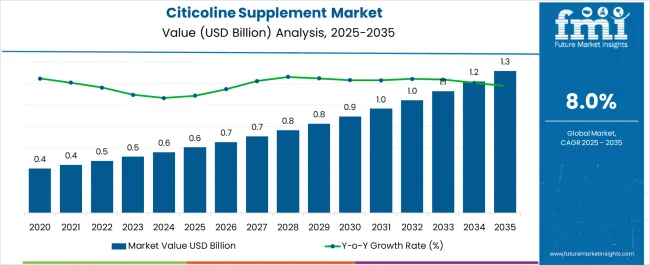
| Metric | Value |
|---|---|
| Citicoline Supplement Market Estimated Value in (2025 E) | USD 0.6 billion |
| Citicoline Supplement Market Forecast Value in (2035 F) | USD 1.3 billion |
| Forecast CAGR (2025 to 2035) | 8.0% |
The citicoline supplement market is experiencing sustained expansion. Rising incidence of neurological disorders, growing awareness regarding cognitive health, and increasing adoption of dietary supplements are driving demand. Current dynamics are influenced by aging populations, the rising prevalence of Alzheimer’s disease and other neurodegenerative conditions, and the growing role of nootropic products in preventive healthcare.
Regulatory frameworks have been evolving to support product quality and safety, which has reinforced consumer confidence. The market outlook is characterized by strong opportunities in both developed and emerging regions, with distribution channels expanding across online platforms and specialty health stores. Growth rationale is underpinned by the scientific validation of citicoline’s role in supporting memory, focus, and overall brain health.
Continuous investment in clinical studies, product innovation, and enhanced formulations are strengthening its adoption in the nutraceutical sector Over the forecast horizon, rising healthcare expenditure and proactive consumer interest in long-term cognitive wellness are expected to support steady revenue growth and wider market penetration.
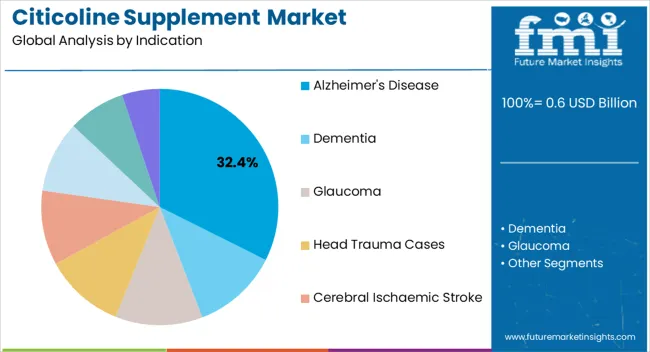
The Alzheimer’s disease segment, accounting for 32.40% of the indication category, has emerged as the leading area of application due to the growing prevalence of neurodegenerative conditions and heightened emphasis on early intervention. Adoption has been supported by expanding awareness of citicoline’s neuroprotective properties and its ability to support cognitive function in patients with memory-related impairments.
Regulatory acceptance and inclusion in supportive care strategies have reinforced its market position. Research-driven validation of therapeutic efficacy has strengthened prescriber and consumer confidence, while ongoing clinical studies are broadening the evidence base.
The segment’s growth trajectory is also being influenced by rising healthcare spending and the availability of dietary supplements as adjunctive support to conventional therapies These factors are collectively ensuring sustained demand and market leadership for citicoline supplements targeting Alzheimer’s disease.
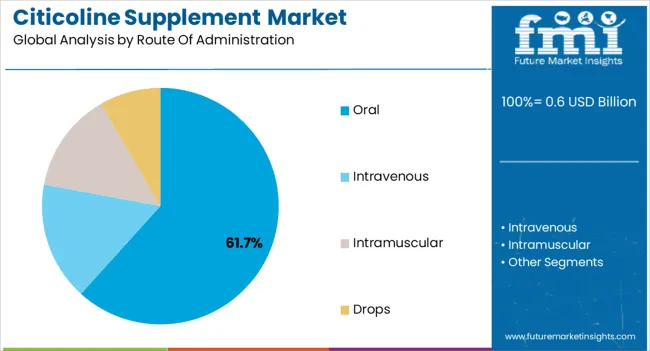
The oral route segment, representing 61.70% of the administration category, has maintained dominance due to convenience, widespread consumer acceptance, and suitability for long-term supplementation. Adoption has been supported by the availability of tablets, capsules, and liquid formulations that meet diverse consumer preferences.
Cost-effectiveness and ease of large-scale production have reinforced its preference among manufacturers and distributors. The oral route’s compatibility with both preventive and therapeutic supplementation strategies has strengthened demand across different age groups.
Expanding e-commerce channels and direct-to-consumer distribution models are further supporting accessibility Continuous product innovation, including enhanced bioavailability formulations, is expected to maintain the segment’s leading position and contribute to consistent market growth over the forecast period.
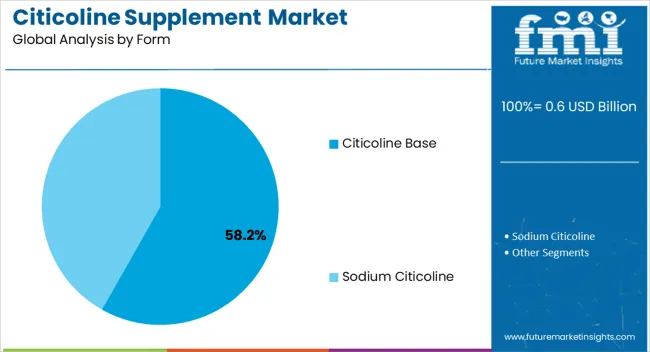
The citicoline base segment, holding 58.20% of the form category, has established itself as the most widely adopted format due to its stability, ease of formulation, and proven effectiveness in delivering cognitive health benefits. Its leadership has been reinforced by strong demand from nutraceutical manufacturers seeking standardized and cost-efficient raw material options.
The form’s adaptability in multiple dosage formats, including tablets and capsules, has enhanced its commercial viability. Regulatory recognition and clinical validation have further strengthened its credibility among healthcare practitioners and consumers.
Ongoing research into improved formulations and synergistic blends with other nootropics is expected to expand its market penetration This dominant position is anticipated to be sustained as consumer demand for reliable and evidence-backed supplements continues to rise globally.
The demand for citicoline supplements is high due to the increasing incidence of neurogenic disorders such as dementia, Alzheimer’s, and diabetic retinopathy. Companies are increasingly focusing on improving one’s brain health and wellness with these supplements.
Exhausting lifestyles, rising competitiveness, prolonged work hours, sleep deprivation, and an aging population are driving demand for functional ingredient-based products that improve cognitive capabilities. Citicoline is becoming more popular in the development of functional ingredients due to its low toxicity and neuroprotective effects.
Citicoline causes the brain to produce phospholipids, which are necessary for neuronal circuits to function properly. With the prevalence of dementia, Alzheimer's disease, and other neurological problems on the rise, governments around the world are extending their assistance to pharmaceutical companies for research.
Growing interest has been observed in preserving and improving cognitive health throughout time. The market for supplements that help to boost brain functions, such as citicoline, has been fueled by this interest.
The global citicoline supplement market has been significantly influenced by the aging of the world's population. Age-related cognitive loss is becoming more widely recognized, which has raised the demand for supplements that promote brain health.
The market for citicoline supplements has benefited from the general trend of interest in nootropics, which are drugs that are thought to improve cognitive performance. The demand for these supplements has increased due to the surging need for new supplements that can help sharpen one’s mind or boost one's attention span.
Market trends have been influenced by ongoing research on citicoline's possible advantages for a range of neurological diseases. Hence, the global citicoline supplement market is expected to rise at a CAGR of 8.4% during the forecast period from 2025 to 2035. From 2020 to 2025, the market expanded at a CAGR of 7.0%.
| Attributes | Key Factors |
|---|---|
| Citicoline Supplement Market Trends |
|
| Growth Hindrances |
|
| Upcoming Opportunities |
|
In the table below, the CAGRs of the leading countries are given for the review period 2025 to 2035. India is expected to remain dominant by exhibiting a CAGR of 7.8%. Japan and China are anticipated to follow with CAGRs of 7.6% and 7.2%, respectively.
| Country | Forecast CAGR (2025 to 2035) |
|---|---|
| United States | 6.9% |
| China | 7.2% |
| Germany | 6.5% |
| India | 7.8% |
| Japan | 7.6% |
The United States dominates North America’s citicoline supplement market. It held a total market share of 89.4% in 2025 and is expected to continue this growth trajectory throughout the forecast period. Increasing spending on health benefits and personal care has been boosting the market for citicoline supplements.
It is essential to comprehend customer trends. Product options can be influenced by variables such as tastes in natural or organic goods, interest in certain formulations, or inclination toward particular dosage forms. It is impossible to exaggerate the importance of internet sales channels for supplements. Consumer choices are influenced by several factors, including the ease of online buying, information availability, the impact of consumer spending habits, and the state of the economy.
Changes in the economy can have an effect on the demand and affordability of dietary supplements, such as citicoline. The demand for supplements that enhance cognitive health is projected to be driven by the country's health and wellness culture, which places a strong emphasis on preventative healthcare.
India held around 26.7% share of South Asia’s citicoline supplement market in 2025. The country is estimated to display growth at a lucrative CAGR of 7.8% during the evaluation period. The market is expected to propel in the forecast period owing to the increasing aging population and high demand for brain health supplements.
The distribution of citicoline supplements to customers is set to be impacted by the popularity of online shopping, health food shops, pharmacies, and other retail establishments. There will probably be several brands selling citicoline supplements in India’s market, creating a competitive environment.
Product differentiation, marketing strategy, and the tactics of key players can influence market dynamics. Product innovation and market expansion would be influenced by ongoing research and development projects carried out in India by universities, research centers, and supplement manufacturers.
Germany is set to exhibit a CAGR of 6.5% in Europe’s citicoline supplement market during the forecast period. Germany is becoming increasingly popular when it comes to improving quality of life and increasing research & development on creating novel products. These would provide quality and efficacy, thereby augmenting the market.
In general, the dietary supplement industry in Germany is sizable and varied. Within this booming business would be the market for supplements containing citicoline. Evaluations of the market's size and growth rates would be essential to comprehend the environment.
Demand is projected to be impacted by high consumer awareness of the advantages of citicoline supplements and cognitive health. The market will likely be driven by a rising interest in cognitive improvement and brain health.
China’s citicoline supplement market is expected to surge at a CAGR of 7.2% by 2035. Health and longevity are highly valued in China. Product awareness among consumers is frequently high for items that promote general well-being and encourage an active, healthy lifestyle.
China is renowned for its technological and scientific breakthroughs. Market expansion is set to be aided by ongoing studies on the advantages of citicoline for cognitive health and related fields. It is vital to comprehend the distribution methods that are widely used in China. Customers' ability to obtain citicoline supplements can be impacted by the dominance of specific retail outlets, pharmacies, or internet platforms.
Japan’s citicoline supplement market is estimated to expand at a CAGR of 7.6% in the evaluation period from 2025 to 2035. There are particular laws controlling dietary supplements in Japan.
It is essential for market entrance and operations to comprehend and abide by these rules. These are set to involve obtaining permissions from the Ministry of Health, Labor, and Welfare (MHLW).
In Japan’s market, consumer preferences and cultural considerations are important. Successful market penetration requires an understanding of the cultural environment and preferences around health and wellness goods.
The population of Japan is aging quickly, and worries about age-related health, particularly cognitive health, are becoming more widespread. The demand for supplements such as citicoline, which is frequently linked to cognitive assistance, can increase as a result of this demographic trend.
The table below signifies leading sub-categories under indication, route of administration, distribution channel, and form categories in the citicoline supplement market. Glaucoma is expected to dominate the market for citicoline supplements by exhibiting a 9.4% CAGR in the evaluation period. Under the route of administration category, the oral segment is projected to lead the global market at a 9.2% CAGR.
| Segment | Value-based CAGR (2035) |
|---|---|
| Glaucoma (Indication) | 9.4% |
| Oral (Route of Administration) | 9.2% |
| Retail Pharmacies (Distribution Channel) | 9.2% |
| Sodium Citicoline (Form) | 8.6% |
The glaucoma segment under indication type is expected to witness high growth at a CAGR of 9.4% through 2035, with a projected market share of about 20.1% in 2025. Citicoline is set to possess neuroprotective qualities, suggesting that it can aid in the defense of nerve cells, especially those found in the optic nerve. This characteristic is relevant in diseases such as glaucoma, where loss of vision can result from injury to the optic nerve.
Clinical research on the use of citicoline to treat glaucoma has been conducted. To determine the efficacy and safety of citicoline for this indication, more studies are necessary as the current data is inconclusive.
There are several forms of citicoline supplements on the market, such as pills or capsules for oral use. The best form for possible advantages in glaucoma would need more research, as the dose and formulation utilized in clinical trials can differ.
The oral route of administration held a citicoline supplement market share of 51.3% in 2025 and is expected to display steady growth over the forecast period. Owing to the rise of consumers seeking easy availability and consumption, the ease of access to multiple dosage patterns, simple packing procedures, and cost-effectiveness have been boosting growth.
Customer preference is frequently a key factor in a product's success. The ease of capsules or tablets over alternative forms, including powders or liquid formulations, is well-known to and preferred by several customers.
The oral method permits precise doses, particularly when it comes to supplements where exact amounts are required to produce the intended results. This is especially vital when it comes to capsules or pills.
Most of the time, tablets and capsules work well for packing since they shield contents from light and moisture. Owing to this, citicoline supplements are more stable and have a longer shelf life.
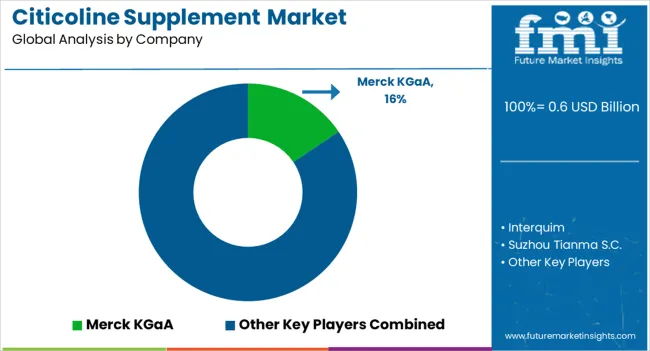
There are both native and foreign players in the market. Leading market players are concentrating on initiatives including new product releases, partnerships, mergers and acquisitions, worldwide expansion, and others, according to brand share analysis.
For instance,
The global citicoline supplement market is estimated to be valued at USD 0.6 billion in 2025.
The market size for the citicoline supplement market is projected to reach USD 1.3 billion by 2035.
The citicoline supplement market is expected to grow at a 8.0% CAGR between 2025 and 2035.
The key product types in citicoline supplement market are alzheimer's disease, dementia, glaucoma, head trauma cases, cerebral ischaemic stroke, cognitive impairment, attention deficit-hyperactive disorder (adhd) and others.
In terms of route of administration, oral segment to command 61.7% share in the citicoline supplement market in 2025.






Full Research Suite comprises of:
Market outlook & trends analysis
Interviews & case studies
Strategic recommendations
Vendor profiles & capabilities analysis
5-year forecasts
8 regions and 60+ country-level data splits
Market segment data splits
12 months of continuous data updates
DELIVERED AS:
PDF EXCEL ONLINE
Supplements And Nutrition Packaging Market
Supplementary Protectors Market
ACF Supplements Market Size and Share Forecast Outlook 2025 to 2035
Food Supplement Ingredients Market Size and Share Forecast Outlook 2025 to 2035
Viscosupplementation Market Analysis - Size, Share, and Forecast Outlook 2025 to 2035
PDRN Supplements Market Size and Share Forecast Outlook 2025 to 2035
Viscosupplementation Industry Analysis in Europe - Size, Share & Forecast 2025 to 2035
Feed Supplements Market Analysis - Size, Share & Forecast 2025 to 2035
Sleep Supplement Market Size and Share Forecast Outlook 2025 to 2035
Gummy Supplements Market Size and Share Forecast Outlook 2025 to 2035
Fiber Supplements Market Size and Share Forecast Outlook 2025 to 2035
Vegan Supplements Market Analysis by Ingredient Type, Form, Customer Orientation , Sales Channel and Health Concer Through 2035
Analysis and Growth Projections for Green Supplement Business
Andro Supplements Market
Beauty Supplements Packaging Market Size and Share Forecast Outlook 2025 to 2035
Herbal Supplement Market Analysis - Size, Share, and Forecast Outlook 2025 to 2035
Beauty Supplement Market Analysis - Size, Share, and Forecast Outlook 2025 to 2035
Biotin Supplement Market Analysis – Size, Share & Forecast 2025 to 2035
Energy Supplement Market Analysis by Product Type, End-user and Distribution Channel through 2025 to 2035
Urology Supplements Market Size and Share Forecast Outlook 2025 to 2035

Thank you!
You will receive an email from our Business Development Manager. Please be sure to check your SPAM/JUNK folder too.
Chat With
MaRIA